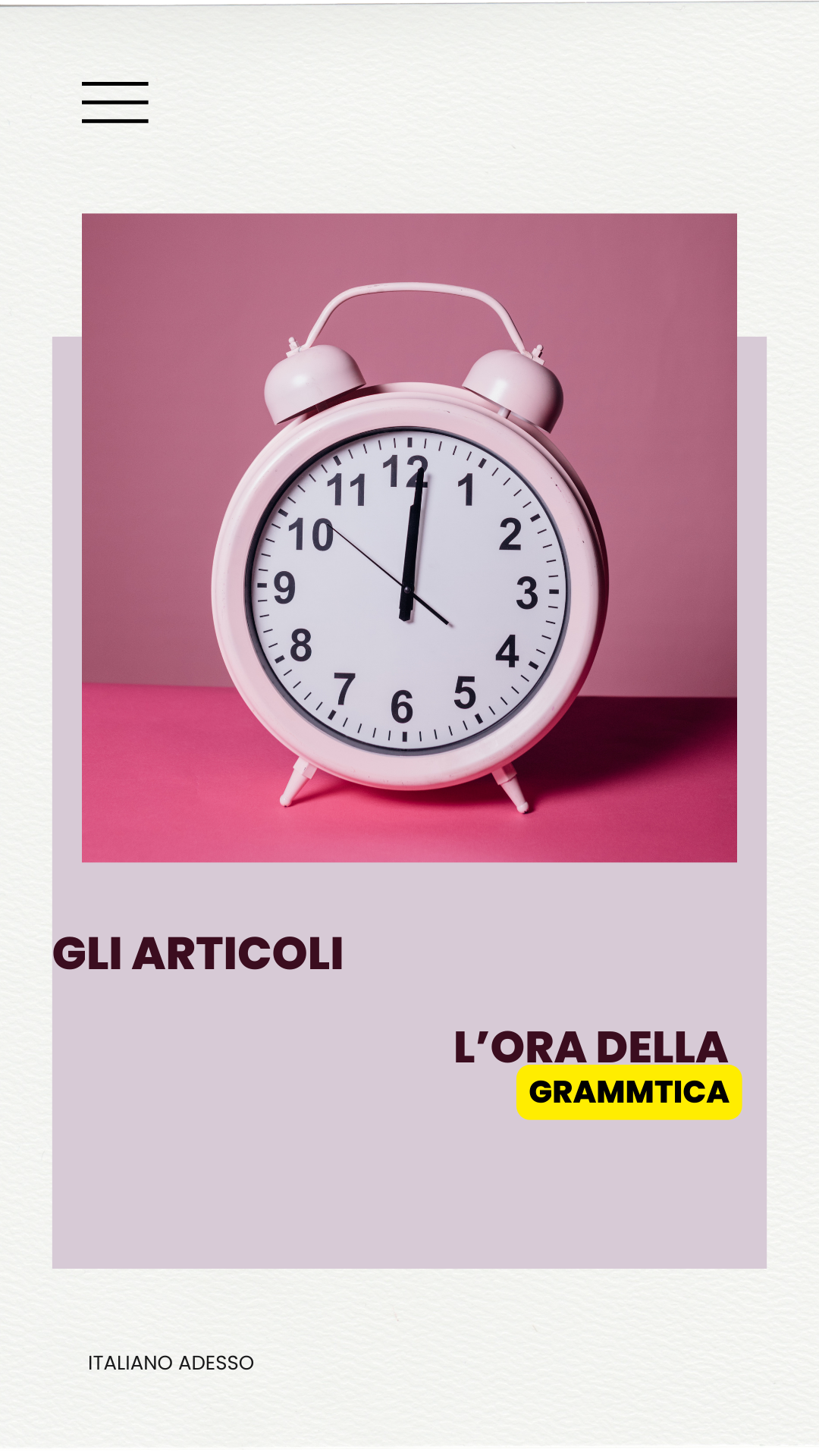
Ehilà! Good to see you! In this article I’m going to introduce to you the Italian articles and how to use them properly.
First of all, there’s an important thing to point out: in Italian there are two types of articles, the definite articles (articoli definitivi) and the indefinite articles (articoli indefinitivi).
DEFINITIVE ARTICLES
While, in English, there’s only one definitive articles – “the” – used to indicate one (or more) specific thing(s), in Italian there are multiple forms of definitive articles depending on the grammar gender of nouns and on the quantity of things, people, animals etc.
Note: if you have trouble understanding if a noun is feminine or masculine, just remember that – in most cases – when a noun ends with an a it is feminine; when it ends with an o, it is masculine.
| Masculine | Singular | Plural | How to use | Examples |
| Il | I | For masculine nouns that start with a consonant | Il libro = the book Il cane = the dog I gatti = the cats I treni = the trains | |
| Lo | Gli | For masculine nouns that with –s + consonant, –ps, –z, – x, –pn, –gn, –x | Lo psicologo = the psychologist Gli gnomi = the gnomes Lo zoo = the zoo | |
| L’ | Gli | For masculine nouns that start a vowel | L’orto = the vegetable garden L’armadio = the wardrobe Gli aerei = the airplanes | |
| Feminine | La | Le | For feminine nouns that start with a consonant | La casa = the house Le macchine = the cars La chitarra = the guitar |
| L’ | Le | For feminine nouns that start with a vowel | L’ombra = the shadow Le amiche = the friends |
It might seem difficult at first, but I can guarantee you that it is just a matter of practice! Speaking of which, here are some easy and funny exercise to find out what I’m talking about!
1. Find the right definite article for each noun (answers at the end)
A) ____ pappagallo (parrot)
☐ a) l’
☐ b) lo
☐ c) il
☐ d) i
B) ____ maestra (teacher)
☐ a) la
☐ b) le
☐ c) il
☐ d) l’
C) ____ tavolo (table)
☐ a) lo
☐ b) il
☐ c) gli
☐ d) la
D) _____ amaca (hammock)
☐ a) la
☐ b) lo
☐ c) l’
☐ d) le
E) ____ ombrelli (umbrellas)
☐ a) gli
☐ b) le
☐ c) i
☐ d) l’
F) _____ zaino (backpack)
☐ a) il
☐ b) lo
☐ c) la
☐ d) gli
2. Turn the singular noun into plural (answers at the end)
A) La strada (street) → ……….
B) Il semaforo (traffic light) → ………
C) Lo studente (student) → ……….
D) L’insalata (salad) → ……..
E) L’astuccio (pencil case) → ……..
3. Turn the plural noun into singular (answers at the end)
A) Gli spettacoli (shows) → ……….
B) Le poltrone (armchairs) → ……….
C) Le isole (islands) → …………..
D) I giornali (newspapers) → ……..
E) Gli anelli (rings) → ………..
INDEFINITE ARTICLES
To indicate a generic element of a whole, in English, we use the indefinite articles a and, when a noun starts with a vowel, we use an. The use of Italian indefinite articles depends, once again, on the gender of the noun that follows. The
only difference is that Italian indefinite articles does not present a plural form, although you could make it in different ways.
| Masculine | Singular | How to use | Examples |
| Un | For masculine nouns that start with a consonant or a vowel (you can’t use un’ with masculine nouns) | Un libro = a book Un cane = a dog Un armadio = a wardrobe | |
| Uno | For masculine nouns that with –s + consonant, –ps, –z, –x, –pn, –gn, –x | Uno studente = a student Uno sgabello = a stool Uno gnomo = a gnome |
Feminine
Una
For feminine nouns
that start with a consonant
Una casa = a house
Una finestra = a window
Un’
For feminine nouns
that start with a vowel
Un’ombra = a shadow
Un’amica = a friend
In order to make the plural form of the Italian indefinite articles, you can use the indefinite adjectives certi/certe or alcuni/alcune, which is the Italian version of “some”.
Here are some examples of the use of certi/certe and alcuni/alcune:
• Certe persone amano passeggiare la notte → Some people love to take a walk by night
• La scuola è finita alcuni giorni fa → The school year ended some days ago
Just as for the definite articles, I believe it is really useful for you to test yourselves with some exercises.
4. Find the right indefinite article for each noun (answers at the end)
A) ______ matita (pencil) ☐ a) un’
☐ b) un ☐ c) una ☐ d) uno
B) _______ albero (tree) ☐ a) una
☐ b) un ☐ c) uno ☐ d) un’
C) ______ arancia (orange) ☐ a) una
☐ b) un’☐ c) uno ☐ d) un
D) ______ braccialetto (bracelet) ☐ a) un
☐ b) un’☐ c) uno ☐ d) una
E) ______ scoglio (cliff) ☐ a) una
☐ b) uno ☐ c) un’☐ d) un
F) ______ zoo (zoo) ☐ a) uno
☐ c) una ☐ d) un ☐ e) un
G) ________ uccello (bird) ☐ a) un’
☐ b) un ☐ c) una ☐ d) un
Che te ne pare?1 I hope you enjoy this brief lesson and, hopefully, you found it useful for your Italian studings. Don’t
be scared: it really is just a matter of practice! Let me know what do you think about it! Alla prossima, su ItalianoAdesso!
Note a piè di pagina:
1 Che te ne pare? = What do you think about it? How’s that? How’s that sound? (You can also say Come ti sembra? Che ne pensi? Che ne dici?)





